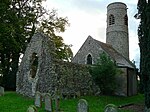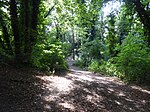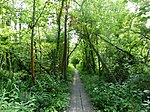Caistor St Edmund is a village and former civil parish on the River Tas, now in the parish of Caistor St Edmund and Bixley, South Norfolk, England. The parish covered an area of 6.55 square kilometres (2.53 sq mi) and had a population of 270 in 116 households at the 2001 census, the population increasing to 289 at the 2011 Census. On the 1st of April 2019 the parish was merged with Bixley to form Caistor St Edmund and Bixley.The remains of a Roman market town and capital of the Iceni tribe, Venta Icenorum, are nearby (British National Grid ref TG230034). The ruins are in the care of the Norfolk Archaeological Trust and managed by South Norfolk Council. It is assumed that the Roman 'Stone Street' runs from Dunwich on the Suffolk coast to Caistor St Edmund. The parish church of St Edmund's lies at the south-east corner of the old Roman town. Caistor St Edmund features on the Antonine Itinerary, a Roman "road map" of the routes around Britain.
The villages name means 'Roman site'. The church is dedicated to St. Edmund hence that addition to distinguish it from Caister-on-Sea.
Caistor Old Hall was built in 1612 for Thomas Pettus. During the 19th century it was owned by John Spurrell (son of William Spurrell, of Thurgarton, Norfolk). The River Tas passes under Markshall bridge, just north of the Roman camp, and then flows on towards Arminghall and Trowse.
The village has one hotel, Caistor Hall Hotel, a fine example of Georgian building constructed between 1795 and 1797 by the Dashwood family. The actual site can be traced back even further to before the Norman Conquest and originally belonged to the Abbey at Bury St Edmunds until it was confiscated during the Dissolution of the Monasteries. Caistor Manor and land then passed to the Godslave family who owned it until the early 1600s and then in turn to the Pettus family. Through marriage the land became the property of the Dashwoods in 1793. The first recorded owner was Horatio Dashwood who lived in the hall with his wife Harriet and their children.












